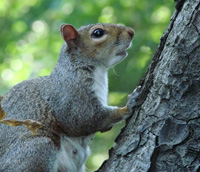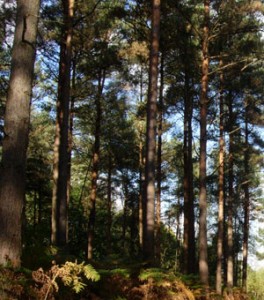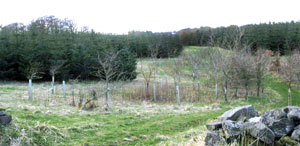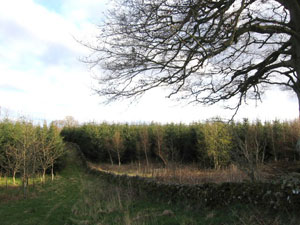Red squirrels in Scotland.
Threats to red squirrels.
The red squirrel is a delightfully charismatic species, which was once a common native over the whole of the UK, but in England is now restricted to a few small areas. In Scotland, the situation is better, but even here there are only about 120 000 individuals. They represent 75% of the total UK population and are under serious threat, so any actions to protect them are to be welcomed. There are two key threats,
- changes to the woodlands in which they live, and
- the so far relentless spread of the similar, but larger American grey squirrel.
The grey squirrel has now entirely replaced the red squirrel in most of England, with a total UK population of over 2.5 million. Unless steps are taken to prevent it, their spread through Scotland will mark the end for red squirrels here too.
 Introduction of grey squirrels.
Introduction of grey squirrels.
Grey squirrels were introduced into parks in the UK in the 19th century and are able to make effective use of a variety of foodstuffs, such as acorns, that are indigestible to red squirrels. Their larger size and higher reproductive rate also help greys outcompete reds for food and habitat, but most ominously, greys carry the Squirrel Poxvirus. This has no effect on the carrier grey squirrel, but is rapidly and painfully fatal to any red squirrel that contracts it from the grey population. Fortunately, not all greys carry the virus and so far, those tested in North East Scotland have been virus free, but the danger is still there.
Red squirrels are a Priority species within the UK Biodiversity Action Plan, and are specifically protected in both the Wildlife and Countryside Act 1981 and the Wild Mammals (Protection) act 1996. While red squirrels are still common in Continental Europe, their loss from the UK would be a tragedy.
 Diet and habitat preference for red squirrels.
Diet and habitat preference for red squirrels.
Red squirrels are seed eaters, preferring the cones of pine, larch and spruce, but also shoots and fruits of other species, fungi and sometimes birds' eggs. They do not hibernate but when food is plentiful in autumn, they put on weight and store food for the winter months. Red squirrels are now largely restricted to large patches of mixed coniferous woodland, while the greys dominate broadleaved woodland. They can live for up to 7 years, and when mature, mate between January and May, producing one or sometimes two litters of 3 or 4 kittens, which become independent at 10-14 weeks when they establish their own territories. It is therefore important that there should be a suitable quantity and variety of food available to sustain the population. In mixed woodland, reds can manage with about 1 ha per animal, but may need around 10 ha in coniferous woodland. The larger and more efficient greys can survive at densities of up to 8 per hectare in broadleaved woodland.
Red squirrels and woodland management.
Where they are still present, woodland management to favour red squirrels should ideally aim to provide as large as possible blocks or connected areas of woodland with high diversity in tree species and age structure. Both species and age diversity are important so as to provide a regular food source throughout the year and over successive years. Species favoured by red squirrels are generally small-seeded, conifers and broadleaved.  Norway spruce, Scots, Lodgepole and Corsican pines, larch and douglas fir are preferred conifers, and hawthorn, blackthorn and cherry among broadleaves. Sitka spruce is less attractive. Large-seeded broadleaves such as oak and beech attract grey squirrels and so should not be encouraged (so long as this is compatible with other aspects of biodiversity management). Wherever possible, clear-felling of large areas of diverse coniferous woodland should be avoided. Where both grey and reds are present, protection or expansion of the red population will depend on humane control of the greys. This can be an emotive issue, and any control must be carried out using approved trapping methods by properly trained operatives. Grant funding from several agencies is available to support creation and improvement of woodland for the benefit of red squirrels.
Norway spruce, Scots, Lodgepole and Corsican pines, larch and douglas fir are preferred conifers, and hawthorn, blackthorn and cherry among broadleaves. Sitka spruce is less attractive. Large-seeded broadleaves such as oak and beech attract grey squirrels and so should not be encouraged (so long as this is compatible with other aspects of biodiversity management). Wherever possible, clear-felling of large areas of diverse coniferous woodland should be avoided. Where both grey and reds are present, protection or expansion of the red population will depend on humane control of the greys. This can be an emotive issue, and any control must be carried out using approved trapping methods by properly trained operatives. Grant funding from several agencies is available to support creation and improvement of woodland for the benefit of red squirrels.
Protecting and saving the red squirrel in Scotland.
The Scottish Wildlife Trust’s “Saving Scotland's Red Squirrels” project (SSRS), funded by the Forestry Commission Scotland, Scottish Natural Heritage and the Scottish Rural Property and Business Association, has been set up to provide management advice and actions to support the surviving red squirrel populations. North East Scotland is fortunate in that it still has a flourishing red population and greys are mainly restricted to Aberdeen itself (where they were introduced into the city's parks). However, greys have been spreading along the river valleys from the city, threatening our red squirrel populations. A strategic grey squirrel control plan has been put in place with the aim of reducing and reversing this spread. In order to determine the success of this programme, a network of monitoring sites has been set up and volunteers record the changes in the two species using a variety of methods.
 Lairshill woodland is one of the monitoring sites, and feeder boxes baited with peanuts, seeds and maize have been set up, with “sticky pads” under the box lids. These collect hairs from the back of any squirrels entering the feeder box and under a microscope it is possible to identify whether the hair comes from a red or grey squirrel. Lairshill lies between two areas where the greys have been spreading. At present, it is probably too even-aged and monospecific to be ideal for red squirrels, but it is also not attractive to greys. Sympathetic management could increase its attractiveness to the reds, without encouraging the greys to invade, although control of greys will be required if they are ever detected there.
Lairshill woodland is one of the monitoring sites, and feeder boxes baited with peanuts, seeds and maize have been set up, with “sticky pads” under the box lids. These collect hairs from the back of any squirrels entering the feeder box and under a microscope it is possible to identify whether the hair comes from a red or grey squirrel. Lairshill lies between two areas where the greys have been spreading. At present, it is probably too even-aged and monospecific to be ideal for red squirrels, but it is also not attractive to greys. Sympathetic management could increase its attractiveness to the reds, without encouraging the greys to invade, although control of greys will be required if they are ever detected there.
For further details, contact the SSRS Project Officer at [email protected]
see also : http://www.scottishsquirrels.org.uk/
Comments are closed for this post.
Discussion
Hi there. I live in Toronto, Canada, and earlier this year, my wife, Jean, and I were in Ireland where we came upon the rarely seen Red Squirrel. To us, they actually look somewhat like our American Red squirrels, but boy, do they have long ears! We were shocked to learn that U.K. and Irish Red squirrels are contracting the pox virus from Grey squirrels, and dying. We feel very lucky to have seen two Red squirrels in Ireland, and have posted some of our pictures and videos for anyone interested at: http://frametoframe.ca/photo-essay-red-grey-squirrels-canada-ireland
Sorry for the double post, my older post didn’t appear at first and I thought there was maybe an error.
Vivien, the decline of the red squirrel was caused mainly by the grey squirrel, and as Ron Bury has said, this is a well proven and well accepted fact. Today, the grey squirrel is the only remaining threat.
“There has never been a wild animal in Britain that has not been hunted, and I suspect it has more to do with mankind’s desire to hunt than any real reason to do so”
While hunting was done for the sake of killing in the past, how is essential conservation work not a “real” reason?
“Whilst it is true that the grey squirrel has been very successful, I’m not sure that it can be blamed for the demise of the red squirrel, which has suffered from lack of habitat”
It can be blamed. In fact, the grey squirrel has been proven to be the main cause of the decline. Woodland area has more than doubled since 1900 and even in areas with plenty of excellent habitat, grey squirrels cause extinctions of reds. Grey squirrels are the last remaining threat to the reds and their impact on red populations cannot be disputed.
While it is true that red squirrel populations have suffered from destroyed or disrupted habitat it is, non the less, a well proven and accepted fact that the presence of grey squirrels is instrumental in reducing red squirrel numbers, due to competition and disease.
Regardless of how public opinion has changed over the last century and a half, it shouldn’t be used as an excuse to abdicate our responsibilities towards, in some way, mitigating a problem we caused in the first place. It’s extremely unlikely that the north american grey squirrel would have reached Europe by any other means than the hand of man and in that we are entirely responsible.
Ecosystems take time to evolve and any sudden introduction of a species alien to a particular environment will always cause problems. History has shown us this time and time again, when human kind has interfered.
The human race is like a virus which, as it multiplies, is slowly destroying it’s host; and that is the real problem that needs addressing.
Whilst it is true that the grey squirrel has been very successful, I’m not sure that it can be blamed for the demise of the red squirrel, which has suffered from lack of habitat. We should also remember that not so long ago, public opinion held the red squirrel to be every bit as destructive as the grey and they were practically hunted to extinction. It is all to easy to jump on these bandwagons and take it to extremes. When I was a child, Otters were hated and there was a local group of Otter hunters, whose ambition was to destroy every Otter in the area. They pretty well succeded too. There has never been a wild animal in Britain that has not been hunted, and I suspect it has more to do with mankind’s desire to hunt than any real reason to do so.
I don’t believe it’s always fully appreciated just how diverse a Red Squirrels habitat needs to be to secure a reliable year round food supply, or that their leanest time of the year is late spring and early summer.
In the Scottish Highlands there is an attempt by the SNH and the Forestry Commission Scotland in partnership with others, to identify and establish refuge woodlands for Red Squirrels which are predominately large conifer blocks and unattractive to Grey Squirrels.
I sincerely hope that this eventually meets with some success but I personally feel that without strict Grey Squirrel control, will only delay the end of Red Squirrels on the UK mainland.
The Red Squirrel is still very much under recorded west of the Great Glen and the Highland Red Squirrel Group is working hard to redress this.
I was surprised that you failed to mention Hazel in your list of favourite broad leaved foods, and although Sitka Spruce is a tree every one mourning the loss of Scotlands Scots Pine forest loves to hate, they are utilised quite often by Red squirrels.

Late last year DEFRA approved a new vermin trap ostensibly to kill stoats and rats, but DEFRA overlooked the fact that it will also kill red squirrels and hedgehogs.
What makes this trap lethal is that it powered by a compressed gas capsule which enables it to release the kill and reset itself automatically. Again and again for 6 months!
The trap is imported from New Zealand where it was designed to kill hedgehogs which have become a pest there after they were imported from the UK.
Here is a link-
http://www.goodnature.co.nz/pests/#c315
This kill trap cannot differentiate between species. Furthermore because it releases the kill, any scavenger or predator can remove the body so there is no way of knowing how many or what was killed.
There is therefore an urgent need for as many people as possible to bring this to the attention at the highest level.
People should write to:-
Dr Therese Coffey MP
Permanent Under Secretary of State
Dept. for Environment Food and Rural Affairs
Nobel House
17 Smith Square
London SW1P 3JR
DEFRA have been really incompetent in this case and the only way things can change is for pressure from the top.
Good luck.
Tom
Tom Dhu
26 January, 2017